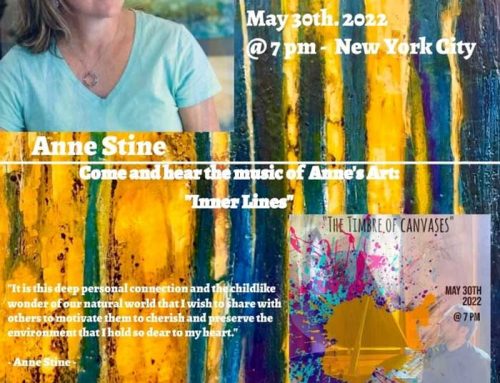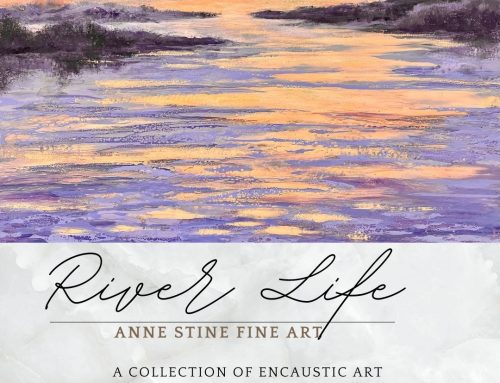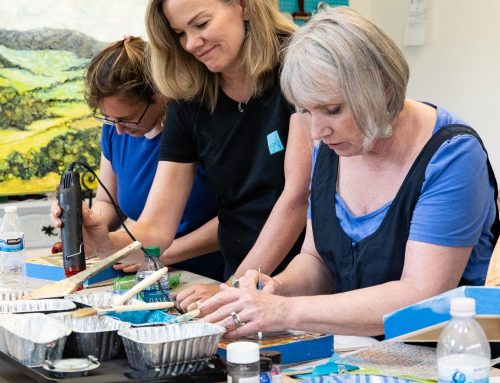
Interview with Tryst Gallery
I had the pleasure of being interviewed by Jim Sisley, owner of Tryst Gallery in Leesburg, Virginia in December 2018 on Facebook LIVE as the Gallery’s featured artist. Click the link or read the transcript below to learn about my creative process, inspiration behind my latest series and my back-story.
Anne Stine Interview with Jim Sisley December 2018
PART ONE and PART TWO on Facebook LIVE.
Anne: My medium is Encaustic Mixed Media. Encaustic is beeswax that is mixed with a pigment and damar resin, a tree sap. It comes solid if you buy it but I create it by mixing all of those elements together over a hot plate. It is completely solid and you have to melt it to use it up to 200 degrees. The way that I work with it is in tins on a hot plate so it becomes molten. Then I’m able to paint on a wood panel but it solidifies as soon as it’s off the heat source. I have to reapply the heat with a blow torch and heat gun. When I reapply the heat it’s able to become molten again on the surface so then I’m able to maneuver it and move it as I wish almost using fire and heat like a paint brush.
Jim: That’s amazing you paint with a blowtorch. That’s cool. How did you get started doing this?
Anne: I originally was an acrylic mixed media painter. I love acrylics but it was frustrating especially in collage work, getting each layer to really fuse with the next. I saw an encaustic painting online and couldn’t figure out how they made it. I researched what it was and from then on it was really about self-educating about the medium and working with it over and over with lots of failures until I had an idea of how to manipulate it the way I wanted it.
Jim: So practice makes a real difference in any medium right?
Anne: Right.
Jim: So one of the things that I read about the medium is that this is a very ancient form of art and they have recorded that they have found encaustic works in the Roman ruins. So it’s a very durable medium because of the hardness right?
Anne: Absolutely. There are paintings in museums today that are over 2000 years old. It first originated in 1 or 2 BC when Rome occupied Egypt and the Egyptians used the wax to paint the portrait, on a wood panel of that person who had been mummified. They are just as beautiful as they were back then.
Jim: Yes it’s amazing. Every time I see one of the old pieces and think about what it would take to preserve it over all those years. Do you have any of that old work?
Anne: Yea, no.
Jim: The interesting thing is that the beeswax is the key. Because of its antifungal and antibacterial properties, it’s mildew and fungus resistant.
Anne: Yes, it’s able to preserve even more than oil paint.
Jim: So did you take lessons in this medium? I know you were an artist before, who taught you?
Anne: This is called the life of hard knocks and hours and hours of playing with the medium and of course reading everything I could, looking at every video that I could find from other very generous artists online that share their work on YouTube showing how to work with the medium. Then it came down to determining how I wanted to use it, how I was going to use it the way I wanted to, and how I was going to get the expression and my interpretation.
Jim: Anne has been with us from really the earliest days, maybe the second or third show we’ve had. You’ve shown a lot of subject matter. This show is all about water.
Anne: It’s called Living Water.
Jim: Good title, how did you decide on the subject matter?
Anne: Twofold. First of all, working with the medium itself, because of its molten properties it flows like water. And when you apply it to the board and you are heating it, it will drip and ooze and cascade down the panel, so that immediately was inspiration right there. I thought if this moves like water, let me really make it move like water and see what I can do with it. There’s a beautiful sheen to encaustic. Especially working with the layers of wax. I work with it pigmented and also work with clear medium. When I lay multiple layers, and I put anywhere from 1o to 20 layers on a painting, I’m also applying that clear medium to show the depth. I then gouge into it or sculpt into it to produce ripples and reflections.
Jim: So this piece, Motion, is a great piece. It’s a very challenging piece. I haven’t seen you paint water as prolifically as this show. I was wondering what particular challenges you may have had with that. It’s a very chaotic scene.

“Motion” encaustic mixed media, 48″x36″ wood panel
Anne: It’s not chaotic, it’s passionate! (laughing)
Jim: You captured chaos. There’s never going to be a repeat, if that was a photograph it never gets to be a repeat.
Anne: First of all, working with a board this size was a challenge. That thing is massive; I hurt my shoulder when I was creating that one. (laughing) To get the image of flowing water, I had to paint the encaustic then take the hotgun and tilt the board a certain way so that wax would move the way I wanted it to.
Jim: It’s very organic. Honestly that’s one of the things about your encaustic work, I can’t say that I have a whole lot of other folks to compare it to, but your encaustic work you’re really letting the medium do the work. You’re letting it go where it wants to go. That’s a big struggle for a lot of artists. It’s the difference between people that really can use paint or whatever the medium is to accentuate the subject that they’re trying to get down, regardless of what their technical skills are. You seem to me to be a very technically astute and capable encaustic artist.
Anne: Well, thank you, Jim. The best part of working with a medium such as encaustic for me is the creativity and its unpredictability. That’s why I don’t see myself going back to being a traditional acrylic painter. I do use oils because you can’t mix acrylic with encaustic, it’s like oil and water. I’m working with oils and pastels and infusing them into the wax and becoming more and more educated about oil and how it works with encaustic.
Jim: The physical properties?
Anne: Absolutely.
Jim: That’s very exciting, I don’t know if you’ve studied a lot of the chemical compositions of the different media components that you put into it but what have you discovered? I think that people would want to know that.
Anne: For encaustic itself, there’s a very specific ratio when you’re mixing the Damar Resin with the pigment and the wax. You have to know what you’re looking for. It could be too soft or too hard. If it’s too hard it would become brittle and you don’t want that to happen. If it’s too soft, it’s just not going to solidify. I work with a 1 to 8 ratio of resin to encaustic then a 20% addition of pigment. Some artists will go a little softer or harder, but that’s what works for me. I use pigment powder and oils to pigment the wax.
Jim: Pigment powder, I think it creates that opaque quality that I think is in this painting specifically. But you’re also doing washes as well. I see a clear and see-through application of some of the medium.
Anne: That’s putting in less than 20% of the pigment so it becomes more transparent. And then when you are adding a medium onto the encaustic, you have to be aware of how that is going to fuse. Every layer is fused. Whether I put on a layer of pastel or oil or encaustic, it needs be fused or it could separate.
Jim: What happens if it comes apart?
Anne: Well you don’t have that archival permanence. Especially as a mixed media or collage artist, everything must fuse. Each layer should be properly embedded with each other so it doesn’t come apart and have an archival quality.
Jim: There were a lot of great painters who didn’t believe in that
Anne: I don’t want anyone calling me saying their painting is chipping! (laughing)
Jim: In 200 years.
Anne: Yea, right!
Anne: So applying, you asked me how they work together. You can apply oil to the encaustic surface but not too much or it won’t fuse when you heat it. When you use pastels, you have to make sure to rub it with your hand so you doesn’tt have that chalky look. There’s a lot that you learn through experience, through playing with it. Hours of playing with it.
Jim: So subject matter is always a challenge for any artist regardless of medium. I’ve seen you paint a lot of landscapes and I love them all but how do you decide what you’re going to paint. Do you work in themes or do you work in one-offs? Tell us about it. What’s your process?
Anne: Nature is very important to me. I have a deep spiritual connection to nature. To me, nature is my church. I grew up in Virginia and I would walk into the forest across from our house and walk through the pine trees and it would be like a cathedral to me and I have a deep connection with nature and just magnifying the beautiful natural monuments in our world. So that’s important to me as a subject matter. I chose water because the connection of water is also important to me. So yes, the medium itself was an influence, but to me the water is also living because it evokes emotion and it has movement. This piece for instance, that we were talking about before, represents to me the turbulence of life we all experience living on this planet. It might mean something different to someone else but to me that was the feeling behind it. And, that piece across the room, “Quiet Expanse”, is an expression of the stillness of a marsh and the peace that you find when you’re next to a very peaceful, quiet marsh at dusk. It’s all about an emotive inspiration as well as the movement or stillness of water.

“Quiet Expanse”, encaustic mixed media, 30″x40″ wood panel
Jim: You know water I think is one of those elements that it’s never the same. There’s a great old saying that a person can’t step into the same river twice because the person is different and so is the river. Every single time. And one of the things that make it so healing is that reflective quality of light regardless of the time of the day. It could be absolute midnight and you still get reflection in the water. It’s a very difficult dynamic to capture. So I’m curious how you study to capture, do you draw first? Do you do Macketes? How do you approach that you’re able to recreate and capture water?
Anne: The challenge with encaustic is that I can’t paint outside, with all the cords and outlets and electricity and fire that’s required to do what I do. However, I’m exploring this. For my next collection I’m incorporating plein-air. This collection was all done in the studio working from photographs I took of water sites. Most were done at Sleeter Lake in Round Hill, Virginia. It’s a reservoir, a lovely lake that you can go kayaking on. I work from photographs because I‘m able to use them for inspiration. The painting never looks like the photograph.
Jim: I was going to ask. How close?
Anne: I use it as inspiration to get started and let it the creative process take over. You can’t see that piece over there, but that rushing water painting was inspired during an afternoon with my son at a creek in Purcellville.

“Rushing Water”, encaustic mixed meia, 36″x24″
Jim: So you’re not a control freak as an artist. I’m just going to feed this back to you. It seems to me what you’re doing from the photo references, is that you want to get the general feeling of it. And what you’re creating is as much about Anne’s patience, hand and experience with the elements that move it around. Your brush for the lack of a better term than the medium, the paint in painterly terms and you’re okay with it just going that way right?
Anne: Yes. To me that’s art. That’s what brings the heart into a work. I could never see myself doing photorealism. For me, it has to have a piece of my heart in it.
Jim: I think for a lot of painters and I’m hearing that from you as well is that letting the painting go where it wants to go, to let the art piece go where it wants to go allows it to be something that couldn’t be any other way. Right? It’s kind of this partnership between the artist and their medium.
Anne: I call encaustic a naughty child. You try to control it and it just won’t work. You need to give it some space and you have to guide it as opposed to controlling it.
Jim: So I just wanted to touch on the beginning of your art career. Did you go to school anywhere? Are you a self-taught artist?
Anne: I went to Virginia Tech and I studied communications and art and that has helped in my art career. I’ve been able to pull from that.
Jim: What have you pulled from a communications education?
Anne: Well, the business part of art and publicizing the work. I think it’s helped me because being an artist is 50% business 50% creating if you want to make some income from it. It’s helped me to promote my art as well as work it as a business. Studying communications has given me the background I needed to help promote art organizations, other artists, and the art community through social media and print media.
Jim: But you worked in other mediums too?
Anne: Yes, I also studied art and I’m constantly learning. I’m taking courses whenever I can, learning under masters whenever I can find someone available.
Jim: So, who has been a big influence?
Anne: The impressionists were my biggest influence. Monet is my absolute favorite and I was able to visit his garden last Summer, so I painted some water lilies. You know the iconic waterlily painting you have to paint if you go? (laughing)

“Summer of Reflection”, encaustic mixed media, “24”x24″
Jim: I have to say I see a lot of people trying to do Monet-like work and they use paint or watercolor or something and 99.99% of them all fail and you’ve done it extraordinarily well.
Anne: Thank you. Impressionism is where I’ve parked myself.
Jim: Hard to stay away from. It is a phenomenal thread of work. Who do you buy? Local artists, have you bought any local art lately?
Anne: I love Leanne Fink’s work. I love her use of color. Penny Hauffe’s work is beautiful. I started as a muralist.
Jim: Was it hard to scale down?
Anne: It was a relief to scale down, let me tell you. I did it for 15 years. It was a lot of big work. The piece that broke me was a ceiling. I did a ceiling and I said that’s enough. I put my ladder away and started my original work. Also, I felt as an artist it was time to step away from commission work, being told by someone else what to paint.
Jim: And paint your heart and soul?
Anne: And paint my heart and soul.
Jim: If there were a young budding artist wondering if it was something they should get into and you wanted to give them some words of wisdom of your travel down the artistic road, what would it be?
Anne: I’m a big believer in following your dreams. I didn’t start out as a young person thinking I was going to be an artist. But, I had a dream and I never let it go. Jut immerse yourself in what you love and be around people who love art and people who encourage you. I have an amazing friend group and an amazing husband and family that really promote me and encourage me every step of the way. Keep following that dream. Also, study under people whose art you love.
Jim: Ladies and gentlemen I just want to thank Anne Stine for her time.





Leave A Comment
You must be logged in to post a comment.